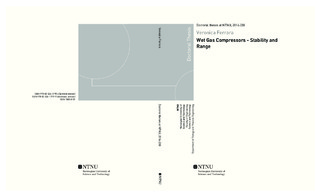| dc.contributor.advisor | Bakken, Lars Eirik | |
| dc.contributor.advisor | Hundseid, Øyvind | |
| dc.contributor.author | Ferrara, Veronica | |
| dc.date.accessioned | 2016-09-19T12:00:22Z | |
| dc.date.available | 2016-09-19T12:00:22Z | |
| dc.date.issued | 2016 | |
| dc.identifier.isbn | 978-82-326-1799-9 | |
| dc.identifier.issn | 1503-8181 | |
| dc.identifier.uri | http://hdl.handle.net/11250/2408309 | |
| dc.description.abstract | The oil and gas industry is a large user of turbomachinery. The demand for oil and gas is
consistently growing, and changing market conditions require innovative solutions. Operation
and optimization of turbomachinery in a variety of applications is therefore of great interest.
Moreover, potentially extreme environmental procedures mean that innovative design and
operational attributes must be used.
The development and implementation of new subsea technology is an important focus
area to increase petroleum production and recovery from existing fields. The technology will
contribute to the exploitation of small and remote fields and access to fields in very deep
water. A traditional centrifugal compressor may not be applicable for wet gas compression,
because the liquid may cause mechanical damage due to erosion and corrosion of the
compressor components; in addition, the design is not optimized for multiphase flow. In this
research, particular emphasis is given to the wet gas compressor as a more fundamental
knowledge of the impact of liquid is essential with regard to the understanding of
aerodynamic and fluid dynamic compressor behaviour. It is also of vital importance to
identify the mechanisms leading to unsteadiness, like surge and rotating stall. A key element
is the investigation of the machine performance and working range when a liquid phase is
present.
In the present work, attention has been given to the experimental validation of an
advanced facility, equipped with special windows designed for flow inspection. The
experimental tests were performed on an air-water multiphase open-loop test rig, which
consists of a single-stage centrifugal compressor, with a standard three-dimensional impeller
that was tested in dry and multiphase conditions.
The main objective of this research is the study of the stability and the range of the wet
gas compressor at a low mass flow rate. Focus of interest is on the effect of the presence of a
liquid phase. Thus the performance evaluation from dry to wet operating conditions is
fundamental. Moreover the study of the flow path inside the impeller and the diffuser has
great importance in order to clarify the impact of the liquid. In this case the visualization of
the fluid has a central role. The analysis of the working range has been supplemented by the
investigation at off‒design conditions, in particular in the area characterized by low mass
flow rate. An accurate examination of the dynamic pressure trends from dry to wet working
conditions is carried out.
The results show the performance deterioration owing to the content of liquid with
respect to dry working conditions. However the presence of a liquid has a positive influence
on the machine stability and operating range. Through a fast Fourier transform analysis, the
stabilizing effect on instabilities onset is highlighted, compared to normal operations. In
addition, the flow evolution inside the impeller and diffuser is studied. The main flow
patterns, typical of a centrifugal compressor, are revealed also in wet conditions: the impeller
flow presents a jet-wake structure, while in the diffuser a logarithmic spiral path is observed.
Also the characteristic behaviour, like reverse flow that creates a “doughnut” formation,
towards the suction pipe, is documented.
The outcomes that improve the knowledge about the wet gas compressor are a baseline
to define a method in order to conduct multiphase tests and provide a starting point to design
a wet tolerant system. | nb_NO |
| dc.language.iso | eng | nb_NO |
| dc.publisher | NTNU | nb_NO |
| dc.relation.ispartofseries | Doctoral thesis at NTNU;2016:230 | |
| dc.relation.haspart | Paper 1: PDF Veronica Ferrara; Lars E. Bakken.
Wet Gas Compressor Surge Stability. Proc. ASME. 56802; Volume 9: Oil and Gas Applications; Supercritical CO2 Power Cycles; Wind Energy,
Is not included due to copyright avialable at <a href="http://dx.doi.org/10.1115/GT2015-42650" target="_blank"> http://dx.doi.org/10.1115/GT2015-42650</a> | nb_NO |
| dc.relation.haspart | Paper 2: Veronica Ferrara; Lars E. Bakken.
Visualisation of Diffuser Instabilities in a Wet Gas Compressor.
Proc. ASME. 57472; Volume 7B: Fluids Engineering Systems and Technologies,
Is not included due to copyright avialable at
<a href="http://dx.doi.org/10.1115/IMECE2015-50399" target="_blank"> http://dx.doi.org/10.1115/IMECE2015-50399</a> | nb_NO |
| dc.relation.haspart | Paper 3: Veronica Ferrara; Lars E. Bakken.
Instabilities Investigation in Wet Gas Compressor by Flow Visualisation. Proc. ASME. 57311; ASME 2015 Gas Turbine India Conference,
Is not included due to copyright avialable at
<a href="http://dx.doi.org/10.1115/GTINDIA2015-1356" target="_blank"> http://dx.doi.org/10.1115/GTINDIA2015-1356</a> | nb_NO |
| dc.relation.haspart | Paper 4:
Veronica Ferrara; Lars E. Bakken; Stefano Falomi; Giuseppe Sassanelli; Matteo Bertoneri; Alberto Scotti del Greco.
Proc. ASME. 49873; Volume 9: Oil and Gas Applications; Supercritical CO2 Power Cycles; Wind Energy, 2016 -
Is not included due to copyright avialable at
<a href="http://dx.doi.org/10.1115/GT2016-57976" target="_blank"> http://dx.doi.org/10.1115/GT2016-57976</a> | |
| dc.title | Wet Gas Compressors - Stability and Range | nb_NO |
| dc.type | Doctoral thesis | nb_NO |
| dc.subject.nsi | VDP::Technology: 500::Environmental engineering: 610 | nb_NO |

